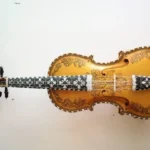
The Pipa, an ancient Chinese musical instrument with roots dating back to the Han Dynasty over 2,000 years ago, embodies a rich tapestry of cultural heritage and musical expression. Evolving from its humble beginnings with four strings and silk or gut frets to the distinctive pear-shaped, five-stringed instrument seen during the Tang Dynasty, the Pipa has become a symbol of Chinese artistry and emotion. Crafted with traditional materials like Mulan and Zitan, the Pipa’s design and construction showcase meticulous craftsmanship. Its strings, once made of silk, have adapted to modern times with the use of nylon or steel. Played with a plectrum and boasting a repertoire that spans from folk music to contemporary compositions, the Pipa remains an emblematic force in Chinese music. In this exploration, we delve into the intricacies of its design, the virtuosity of renowned players, its cultural significance, and its global impact, unraveling the timeless story of the Pipa.
Origin during the Han Dynasty (206 BCE – 220 CE):
The Pipa, an ancient Chinese musical instrument, is believed to have originated during the Han Dynasty, around 2,000 years ago. Emerging during a period of significant cultural development, the early Pipa instruments featured four strings and were fretted with silk or gut. These early versions laid the foundation for the instrument’s evolution, marking its initial presence in Chinese musical history.
Evolution to five strings and pear-shaped body during the Tang Dynasty (618 – 907 CE):
By the Tang Dynasty, the Pipa had undergone significant changes, evolving to have five strings and acquiring a more distinct pear-shaped body. This transformation in design reflected the dynamism of Chinese musical craftsmanship and the desire to enhance the instrument’s tonal qualities. The Pipa’s structural modifications during this era contributed to its versatility and laid the groundwork for its role in various genres of Chinese music.
Traditional materials and construction of the Pipa:
A traditional Pipa is meticulously crafted from wood, featuring a pear-shaped body, a long fretted neck, and a flat soundboard. Mulan, or red sandalwood, is commonly used for the body, while the neck is crafted from Zitan, or violet wood. This careful selection of materials reflects the craftsmanship’s attention to detail, contributing to the instrument’s resonance and aesthetic appeal.
Dimensions and frets of the Pipa:
The Pipa’s physical dimensions play a crucial role in determining its tonal characteristics. Ranging from 33 to 38 inches in length, the instrument boasts 36 frets, traditionally crafted from silk or gut. The incorporation of these frets enables the musician to achieve a wide range of pitches, contributing to the Pipa’s ability to convey diverse emotions and moods.
String materials and modern adaptations:
Traditionally, Pipa strings were crafted from silk, but in contemporary times, nylon or steel strings are often used. This adaptation reflects the ongoing evolution of the instrument and its integration into modern musical contexts. The choice of string material can influence the Pipa’s sound, allowing for greater flexibility and catering to the demands of diverse musical genres.
Playing techniques and tuning of the Pipa:
The Pipa is played using a plectrum, held between the thumb and index finger of the right hand, while the left hand presses the strings against the frets. The instrument offers a rich array of playing techniques, including picking, strumming, tapping, and tremolo, showcasing the virtuosity of skilled performers. The most common tuning for the Pipa is D-A-G-D’-A’, providing a foundation for its expressive and melodic capabilities.
Notable Pipa players in history:
Wang Jianzhi, a virtuoso of the 20th century, is celebrated as one of the most influential Pipa players. His contributions have left an indelible mark on the instrument’s legacy. In the contemporary scene, Wu Man has emerged as a renowned Pipa player, pushing the boundaries of the instrument’s repertoire through innovative compositions and playing techniques. These artists exemplify the Pipa’s enduring appeal and its ability to captivate audiences across different eras.
Versatility in Chinese music genres:
The Pipa’s versatile nature has led to its prominent role in various Chinese music genres, including folk music, opera, and contemporary compositions. Its adaptability across different styles underscores its cultural significance, acting as a cultural ambassador that bridges traditional and modern expressions of Chinese musical artistry.
Cultural symbolism and themes:
The Pipa holds a symbolic place in Chinese culture, depicted in art and literature for centuries. Beyond its musical significance, the instrument is associated with themes of love, loss, and beauty. Its representation in cultural narratives reflects the emotional depth it can convey, making it a cherished component of Chinese artistic expression.
Global adoption and challenges in learning:
While deeply rooted in Chinese culture, the Pipa has transcended borders and been adopted by musicians in other Asian countries, including Korea and Japan. The instrument’s unique sound and rich history, however, contribute to its reputation as a challenging instrument to learn. Its complex playing techniques and intricate tuning system demand dedication and skill, attracting musicians worldwide who are drawn to the rewarding journey of mastering this ancient and culturally significant instrument.
Records of the largest Pipa ensemble:
In 2008, a remarkable musical feat was achieved in China when a performance featuring the largest Pipa ensemble ever recorded took place. A staggering 1,001 Pipa players came together to create a harmonious symphony, showcasing the instrument’s collective power and the cultural significance it holds in uniting large groups of musicians. This event not only set a record but also emphasized the Pipa’s ability to create a captivating and awe-inspiring musical experience on a grand scale.
The most expensive Pipa ever sold:
In 2011, a rare Ming Dynasty Pipa, dating back to the period between 1368 and 1644 CE, fetched an astonishing price of over $1.4 million at auction. This remarkable sale highlighted the instrument’s historical value and the high regard collectors have for exceptional and well-preserved examples of the Pipa. Such transactions underscore the instrument’s cultural and historical significance, transcending its musical value.
International adoption in Asian countries:
The Pipa’s influence extends beyond China, finding a home in other Asian countries like Korea and Japan. In Korea, the instrument is known as “Bipa,” and in Japan, it is referred to as “Biwa.” This cross-cultural adoption emphasizes the Pipa’s adaptability and appeal, showcasing its ability to resonate with diverse musical traditions and contribute to the global tapestry of musical expression.
Challenges in learning the Pipa:
Mastering the Pipa is a formidable task due to its intricate playing techniques and unique tuning system. The complex nature of the instrument demands precision, dedication, and a nuanced understanding of its expressive capabilities. Despite its challenges, the Pipa continues to attract aspiring musicians worldwide, drawn to the allure of its distinctive sound and the rich cultural heritage it represents.
Continued popularity and usage in China:
The Pipa remains a vital and widely used instrument in China, finding a place in both traditional and contemporary music. Its enduring popularity speaks to its cultural resilience and adaptability, as it seamlessly integrates into evolving musical landscapes while preserving its historical and artistic significance.
Annual Pipa performance competitions:
Around the world, several Pipa performance competitions are held annually, providing a platform for skilled musicians to showcase their talent and contribute to the instrument’s ongoing legacy. These competitions foster a sense of community among Pipa enthusiasts, encouraging the exchange of techniques and ideas while ensuring the instrument remains vibrant and relevant in the contemporary music scene.
Versatility in musical styles:
The Pipa’s versatility extends to its ability to play a wide variety of musical styles. From its roots in traditional Chinese folk music and opera to its integration into modern compositions, the Pipa demonstrates its adaptability and relevance across genres. This versatility has contributed to the instrument’s enduring popularity and its ability to connect with diverse audiences.
Cultural symbolism and Pipa themes:
Beyond its musical prowess, the Pipa’s cultural symbolism is deeply ingrained in Chinese artistic traditions. Themes of love, loss, and beauty are often associated with the instrument, making it a poignant storyteller in the rich tapestry of Chinese cultural expression. Its resonance with universal emotions enhances its role as a cultural icon with timeless appeal.
Wang Jianzhi’s influence on the Pipa:
Wang Jianzhi, a pivotal figure in the 20th-century Pipa landscape, left an indelible mark on the instrument’s development. His virtuosity and innovative approaches expanded the Pipa’s repertoire, influencing subsequent generations of musicians. Wang Jianzhi’s legacy highlights the dynamic evolution of the Pipa and its capacity to evolve while maintaining a deep connection to its historical roots.
Wu Man’s contemporary contributions:
In the contemporary era, Wu Man has emerged as a prominent Pipa player, contributing to the instrument’s repertoire with new compositions and playing techniques. Her innovative approach reflects the ongoing evolution of the Pipa, bridging traditional and modern musical expressions. Wu Man’s influence underscores the instrument’s capacity to remain relevant and inspiring in the ever-changing landscape of global music.
Symbolic significance of the Pipa in Chinese culture:
The Pipa is not merely an instrument; it holds profound symbolic significance in Chinese culture. Depicted in art and literature for centuries, the Pipa is often associated with themes of love, loss, and beauty. Its presence in cultural narratives enriches its role beyond a musical tool, making it a symbol that resonates with the deeper emotions and stories embedded in Chinese traditions.
Continued use of traditional materials in Pipa construction:
The meticulous construction of the Pipa using traditional materials like Mulan (red sandalwood) for the body and Zitan (violet wood) for the neck reflects a commitment to preserving the instrument’s authenticity. The use of these materials, known for their resonance and durability, ensures that each Pipa crafted maintains a connection to the historical craftsmanship that has defined the instrument for centuries.
Pipa’s presence in various music genres:
The Pipa’s adaptability is showcased through its presence in a diverse range of Chinese music genres, including folk music, opera, and contemporary compositions. Its ability to seamlessly transition between these styles highlights its versatility, allowing the instrument to contribute to both traditional and evolving musical landscapes, capturing the essence of different eras and expressions.
Global recognition and adoption of the Pipa:
The Pipa’s global recognition is evident in its adoption by musicians in other Asian countries such as Korea (Bipa) and Japan (Biwa). This cross-cultural acceptance underscores the instrument’s universal appeal and its ability to transcend geographical boundaries, becoming a shared cultural treasure that connects diverse communities through a common appreciation for its unique sound and historical significance.
Versatility and challenges attracting new players:
Despite its intricate playing techniques and complex tuning system, the Pipa continues to attract new players worldwide. The instrument’s unique sound, rich history, and its role as a symbol of Chinese culture contribute to its allure. Aspiring musicians are drawn to the challenge of mastering the Pipa, recognizing the rewarding journey of learning an instrument that offers a wide range of expressive possibilities, from traditional melodies to contemporary compositions. The Pipa’s enduring popularity among new generations ensures its legacy remains vibrant in the global musical landscape.
Frequently asked questions:
What is a pipa in musical instrument?
Answer: The pipa (pípá) is a traditional Chinese plucked instrument with a pear-shaped wooden body and four strings.
Why is it called a pipa?
Answer: The name “pipa” comes from the characters “pi” (琵) meaning “to pluck forwards” and “pa” (琶) meaning “to pluck backwards,” referencing the way the strings are played.
How is pipa instrument played?
Answer: The pipa is held upright and the strings are plucked with either a plectrum (pick) or the fingernails. The strings can also be struck, tapped, and vibrated for various sounds and effects.
What is pipa instrument in Korea?
Answer: In Korea, the pipa is called the bipa. However, unlike the Chinese pipa, the Korean bipa is rarely played today, although there are efforts to revive it.









